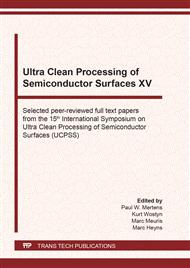p.155
p.161
p.167
p.172
p.181
p.186
p.192
p.197
p.202
Estimation of the Generation Rate of H· Radicals in a Megasonic Field Using an Electrochemical Technique
Abstract:
Radical formation and detection in aqueous solutions under acoustic irradiation are important during wet cleaning processes in semiconductor industries. Oxidizing radicals such as hydroxyl and hydroperoxyl radicals have been widely studied and characterized using fluorescence and chemiluminescence methods. Hydrogen radicals, which are strongly reducing in nature, have not received much attention. In this study, the rate of hydrogen radical generation in a megasonic field (0.93 MHz) was measured using an electrochemical technique. Specifically, the method is based on the reduction of cupric ions to cuprous chloride complex by the hydrogen radicals in the presence of an excess of chloride ions. This is followed by chronoamperometric determination of the oxidation of cuprous chloride complex back to cupric ions. Hydrogen radical generation rate was measured at different megasonic power densities.
Info:
Periodical:
Pages:
181-185
Citation:
Online since:
February 2021
Authors:
Price:
Сopyright:
© 2021 Trans Tech Publications Ltd. All Rights Reserved
Share:
Citation:


